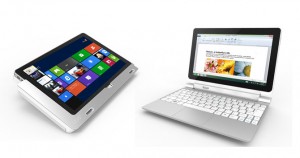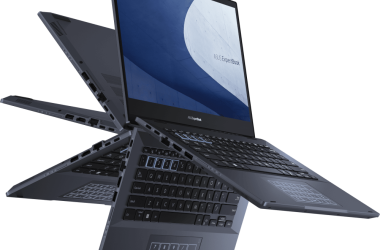 Acer’s Iconia W510 is a 16:9, wides-creen Windows 8 tablet with a nicely designed keyboard dock. When sidled down and locked into said dock, the W5 appears and functions as a small, netbook-sized laptop. Unfortunately, the W5 dock is a pricey option – the $750 W510-1422 and $800 W510P-1406 configurations that include it are $200 more than the otherwise identical dock-less models.
Acer’s Iconia W510 is a 16:9, wides-creen Windows 8 tablet with a nicely designed keyboard dock. When sidled down and locked into said dock, the W5 appears and functions as a small, netbook-sized laptop. Unfortunately, the W5 dock is a pricey option – the $750 W510-1422 and $800 W510P-1406 configurations that include it are $200 more than the otherwise identical dock-less models.
Widescreen tablet
The 16:9 aspect ratio of the Iconia W510’s 10.1-inch, 1366 by 768 display is mirrored by the unit’s 10.2-inch by 7.3-inch form – a form quite common in the Windows 8 tablet realm. The wide aspect is both good and bad news; while 16:9 is perfect for movies, it’s considerably less so when held in portrait orientation to read books or surf the Web – one of the major reasons that 4:3 aspect units have ruled the marketplace. But if video is your focus, the W5’s widescreen can be appealing.
Feature-wise, the Iconia W510 is largely your standard Windows tablet. Features include micro-USB and micro-HDMI ports, an SDHC card reader, a headset jack, plus a 5MP rear-facing camera and a 1.3MP display-side Webcam. There is a Windows button to facilitate alternating between the Windows 8 Metro and classic Windows interfaces, and a rotation lock to fix the image in portrait or landscape mode. Wi-Fi is 802.11 a/g/n and Bluetooth 4.0 are both on hand for top-notch wireless connectivity.
Ho-hum looks
As conceived and realised as the W510’s dock is mechanically, Acer could have done better with its appearance. The W510 looks nice enough on its own, but when combined with the docking station, the two shades of white (dock keys/tablet bezel), black, and silver color scheme give the unit, as a whole, a vaguely cheap feel. Neither part is cheaply made, but visual impressions can be hard to shake.
The docking station keyboard is small, but not overly cramped. The typing feel is a bit dainty, but doable, and the touchpad is decently responsive. The only real complaint is that you can invoke the BIOS and the boot menu using the keyboard, but not navigate within. The dock/keyboard also pivots 180 degrees backward to serve as a simple stand for the tablet, hiding the keyboard and holding the display within easier finger reach.
The weight of the W5 tablet by itself is a comfortable 1.3 pounds. The optional docking station weighs 1.5 pounds, necessary to counterbalance the weight of the tablet. The AC adapter adds another four ounces, so you’re looking at three pounds total with the dock, and 1.7 pounds without.
Performance
In laptop tests, the W510-1422 configuration’s battery life was stellar at nearly 14 hours, 39 minutes. However, performance was strictly tablet. The W510-1422’s dual-core Intel Atom Z2760, 2GB of DDR memory, and 64GB SSD combined for a 17 on PCWorld’s WorldBench 8 test suite – way below par for laptops.
In tablet tests, the system fared far better. Performance was on par with its Atom-based peers, though battery life dropped to only about 8 hours in a continual video rundown test. Subjectively, the W510-1422 unit feels nimble enough, and 1080p video played fine in the Windows 8 video player. The popular VLC player had issues using its own internal codecs, so if that’s your preferred player, you’ll need to set it to use the system codecs.
Bottom line
The W5’s widescreen display will appeal to some, but kill the deal for others – a major conundrum for those eyeing the Surface and other Windows 8 tablets as well. In the end, eying those others might be a good idea – the W510 is a decent product, but it’s not great and there’s a lot of competition.





